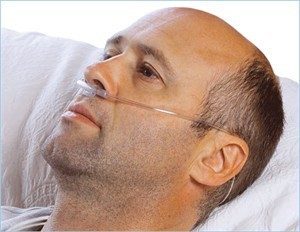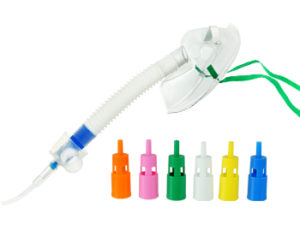Oxygen: delivery devices
Oxygen delivery devices for medical student finals and OSCES
Oxygen therapy
- Oxygen is delivered from taps above ward beds at 100% concentration
- It is then put through different devices at different rates to adjust the oxygen concentration that the patient inspires
- The percentage of oxygen inspired depends on the flow rate and the delivery device
- The flow rate can be set on the wall tap: it varies from 0 – 15L per minute
- Delivery devices work with different flow rates. They include…
Nasal cannulae
- Deliver 24-30% oxygen
- Flow rate 1-4L/min (4L will dry the nose, 2L is more comfortable)
- Used in non-acute situations or if only mildly hypoxic (e.g. saturations stable at 92% in a patient without lung disease)
Hudson mask (rarely used)
- Delivers 30-40% oxygen
- Flow rate 5-10L/min
Venturi mask
- Delivers 24-60% oxygen
- Different colours deliver different rates
- Flow rate: Varies with colour. The correct flow rate to use with each colour it is shown on mask, along with the percentage of oxygen delivered.
- Types:
- BLUE = 2-4L/min = 24% O2
- WHITE = 4-6L/min = 28% O2
- YELLOW = 8-10L/min = 35% O2
- RED = 10-12L/min = 40% O2
- GREEN = 12-15L/min = 60% O2
- Venturi masks are often used in COPD, where it is important not to over-oxygenate the patient.
Non-rebreather mask
- Delivers 85-90% oxygen
- 15L flow rate
- Bag on mask with valves stopping almost all rebreathing of expired air
- Used for acutely unwell patients
- Note that saturations should be maintained at 94-98%, not 100%.
- Do not keep patients on 15L for longer than necessary as over-oxygenating for prolonged periods can be harmful.
Non-invasive ventilation (CPAP/BiPAP): click here for how to start patients on NIV
- CPAP (continuous positive airways pressure)
- High pressure air/oxygen with a tight-fitting mask
- Positive pressure all the time to help keep airways open (split them)
- Used in acute pulmonary oedema and sleep apnoea
- BiPAP (bilevel positive airways pressure)
- High positive pressure on inspiration and lower positive pressure on expiration
- Used in exacerbations of COPD and ARDS
Invasive ventilation
- Fully controlled oxygen delivery up to 100%
- A ventilation bag or machine is attached to an artificial airway to ventilate lungs.
- Used in intensive care and theatre
Click here to learn how to prescribe oxygen
Perfect revision for medical student finals, OSCES and PACES
Click here to learn how to prescribe IV Fluids








